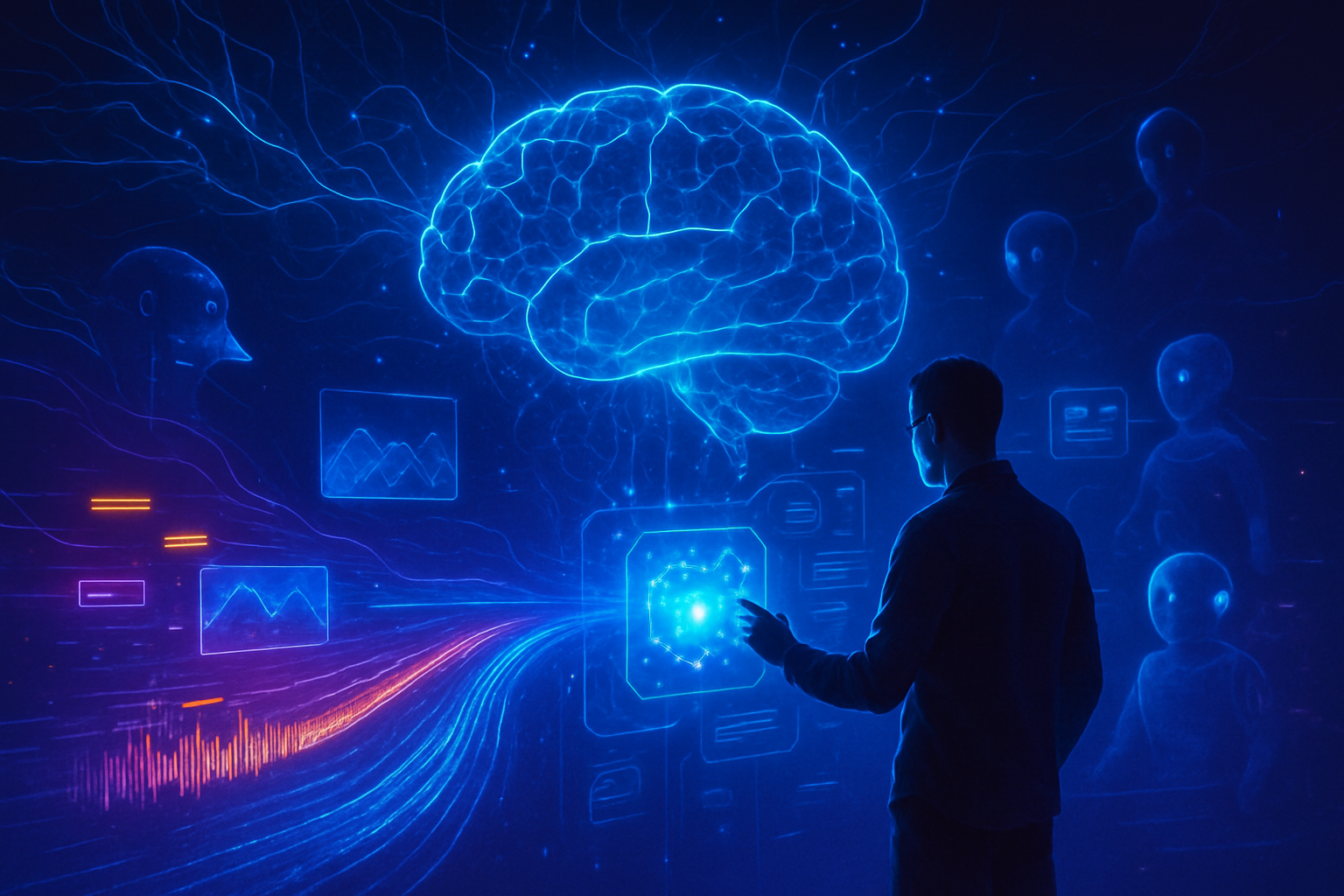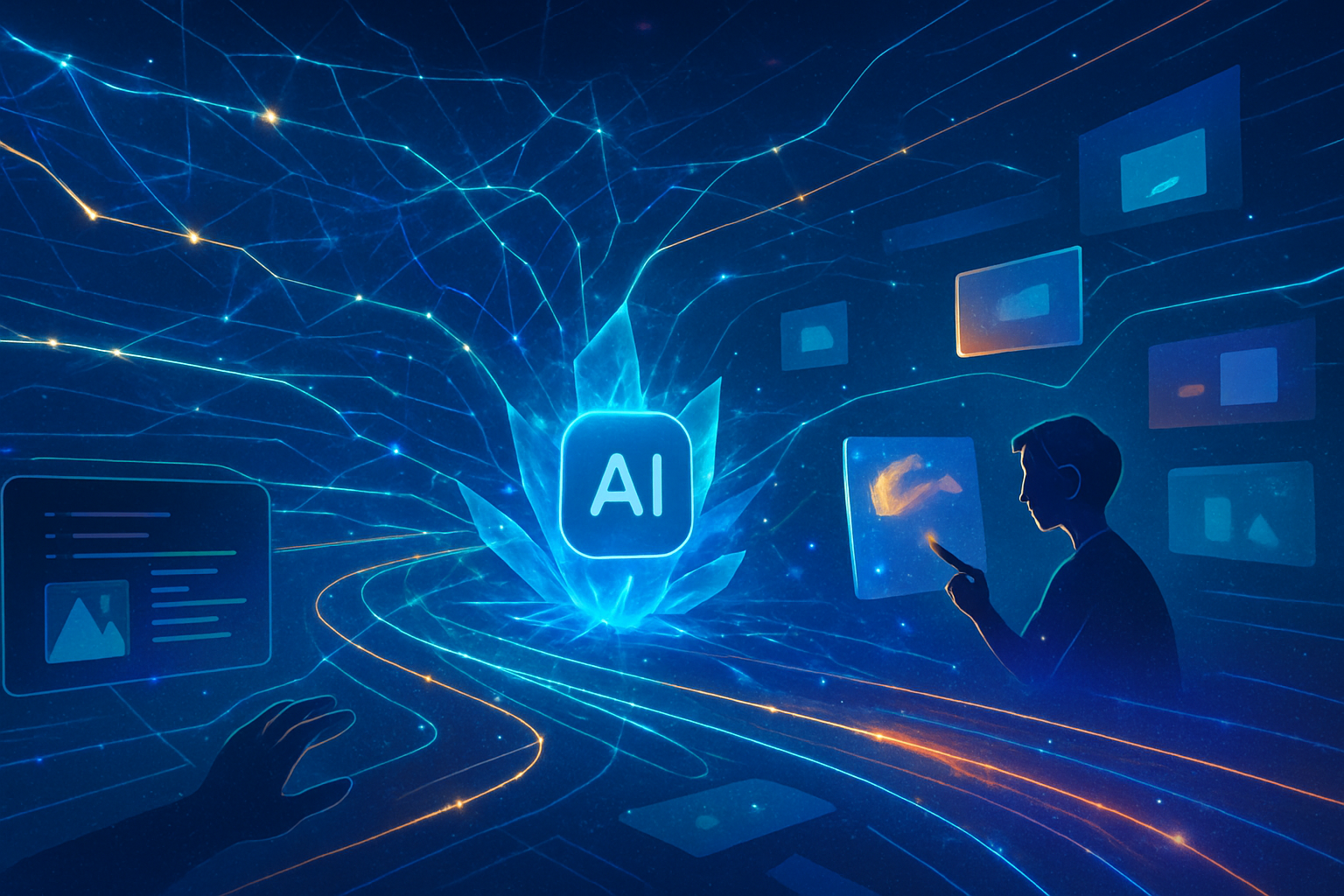Shenzhen, China – December 5, 2025 – DeepSeek AI has officially unveiled its DeepSeek 3.2 model, a groundbreaking advancement in large language models (LLMs) that promises to redefine the landscape of artificial intelligence. Released on December 1, 2025, DeepSeek 3.2, alongside its specialized variant DeepSeek-V3.2-Speciale, introduces a novel architectural approach that delivers competitive performance at an unprecedented cost-efficiency. This release, following its experimental predecessor DeepSeek-V3.2-Exp from September 29, 2025, marks a pivotal moment, pushing the boundaries of what open-source AI can achieve and directly challenging the dominance of proprietary models from established tech giants.
The immediate significance of DeepSeek 3.2 is multifaceted. It pioneers the DeepSeek Sparse Attention (DSA) mechanism, a revolutionary architectural innovation designed to drastically improve efficiency in both training and inference, particularly for long-context tasks. This breakthrough aims to overcome the quadratic computational limitations of traditional Transformer architectures. Furthermore, DeepSeek 3.2 slashes API pricing by over 50%, with input costs as low as $0.07 per million tokens, making it orders of magnitude more economical than leading proprietary models like OpenAI's (NASDAQ: MSFT) GPT-5 and Google's (NASDAQ: GOOGL) Gemini, thereby democratizing access to cutting-edge AI.
Technical Prowess and Architectural Innovation
DeepSeek 3.2, an iteration within the DeepSeek V3 family, maintains a robust base architecture with 671 billion total parameters, with approximately 37 billion active per token thanks to its Mixture-of-Experts (MoE) design. This, combined with Multi-Head Latent Attention (MLA), contributes to its speed and capability. The cornerstone of DeepSeek 3.2's technical advancement is the DeepSeek Sparse Attention (DSA). Unlike traditional attention mechanisms that compute relationships between every token, resulting in a quadratic computational cost (O(L^2)), DSA employs a "lightning indexer" to selectively focus attention on the most relevant tokens. This transforms the complexity to a linear relationship (O(Lk)), yielding significant efficiency gains.
Key capabilities include an impressive 128K token context window, allowing for extensive document processing and multi-turn conversations. The DSA mechanism leads to reported 2-3x speedups and 30-40% memory savings for long contexts during both inference and training. DeepSeek 3.2 is explicitly designed as a "reasoning-first" model for agents. Its high-compute variant, DeepSeek-V3.2-Speciale, integrates the DeepSeek-Math-V2 model and is specifically tuned for deep chain-of-thought and multi-step problem-solving. This variant has achieved gold-medal performance in prestigious international competitions, including the 2025 International Mathematical Olympiad (IMO), International Olympiad in Informatics (IOI), Chinese Mathematical Olympiad (CMO), and ICPC World Finals, placing it on par with or surpassing rivals like Gemini-3.0-Pro and GPT-5 in complex reasoning tasks. DeepSeek 3.2 also marks the first DeepSeek model to integrate "thinking" directly into tool-use workflows, supporting tool invocation in both thinking and non-thinking modes, leveraging a novel large-scale agentic task synthesis pipeline. The models are accessible via OpenAI-compatible API endpoints, offering features like JSON mode, function calling, and a standardized reasoning chain API. Crucially, both DeepSeek-V3.2 and DeepSeek-V3.2-Speciale are released as open-source, providing complete inference code, CUDA kernels, and multi-platform deployment solutions.
Initial reactions from the AI research community and industry experts have been largely positive. DSA is recognized as a "significant and pragmatic engineering achievement," pushing the boundaries of Transformer efficiency. The gold-medal level results of DeepSeek-V3.2-Speciale have garnered significant attention, positioning it as a top-tier open-source model. The drastic reduction in API pricing has been widely praised for democratizing access to high-end AI. While some observers, like Zvi Mowshowitz, suggest that DeepSeek 3.2 might not be "frontier" in all aspects, noting anecdotal reports of slower performance in some practical scenarios compared to its benchmarks, it is universally considered an excellent model within the open-source landscape, especially for those prioritizing cost and openness. Challenges identified include token efficiency and a narrower breadth of general knowledge compared to some proprietary systems due to comparatively fewer training resources.
Reshaping the AI Industry Landscape
DeepSeek 3.2's emergence is sending ripples through the AI industry, impacting tech giants, AI companies, and startups alike. For established tech giants like OpenAI's (NASDAQ: MSFT) Microsoft, Google (NASDAQ: GOOGL), and Anthropic, which primarily offer proprietary, closed-source models, DeepSeek 3.2 presents significant competitive pressure. Its high performance at a fraction of the cost forces these players to re-evaluate their pricing strategies, accelerate their R&D, and further differentiate their offerings with features beyond raw model capabilities, such as safety, robust integrations, and enterprise-grade tooling.
Hardware providers, notably Nvidia (NASDAQ: NVDA), could face a nuanced challenge. While DeepSeek's ability to achieve high performance with optimized software and potentially less advanced hardware might initially suggest a reduced reliance on ever-increasing computational power, the overall surge in AI adoption driven by more affordable models is likely to fuel sustained demand for inference compute. Therefore, chipmakers like Nvidia and TSMC (NYSE: TSM) are still expected to benefit from the growing ecosystem. Hyperscalers such as Microsoft (NASDAQ: MSFT), Amazon (NASDAQ: AMZN), and Meta (NASDAQ: META) might see increased demand for cloud services due to broader AI adoption, but DeepSeek's open-source and efficient nature could also enable companies to opt for more localized or less compute-intensive deployments, potentially eroding some market dominance. Meta, with its own aggressive open-source AI strategy, finds DeepSeek to be a formidable competitor in leading this movement.
For AI startups, DeepSeek 3.2 is largely a boon. Its open-source nature and cost-efficiency democratize AI development, significantly lowering the barrier to entry. Startups can now access cutting-edge AI capabilities without prohibitive licensing fees or massive computational budgets, reducing R&D costs and accelerating innovation. This allows them to shift their focus from developing foundational LLMs to building specialized applications and solutions across various industries, fostering a more creative and inclusive global tech ecosystem. However, it could also intensify competition for startups still aiming to develop their own foundational models, as market attention might gravitate towards more established and efficient open-source alternatives. DeepSeek's disruptive potential lies in proving that top-tier AI can be developed at a fraction of the previously assumed cost, challenging the "Scaling Law" and encouraging a focus on compute efficiency over brute-force scaling.
Wider Significance in the AI Evolution
DeepSeek 3.2's wider significance is profound, aligning with and amplifying several key trends in the broader AI landscape. It stands as a powerful testament to the burgeoning open-source movement, directly challenging the prevailing closed-source paradigm. By providing its models under an MIT license, DeepSeek fosters transparency, collaboration, and innovation, promoting a more diverse and inclusive AI ecosystem that can accelerate research and development globally.
The model embodies a crucial paradigm shift towards "smarter and more efficient architectures" over sheer model size. DeepSeek's innovations like DSA, MoE, and MLA demonstrate that frontier-level performance is achievable with significantly reduced training and inference costs, setting a new standard for resource optimization. This redefines expectations for what's possible in AI development, pushing the industry to explore more sophisticated and sustainable approaches. Furthermore, DeepSeek 3.2 is explicitly designed for agentic AI and tool use, integrating a "thinking mode" for structured, multi-step reasoning. This aligns perfectly with the growing trend towards more autonomous and capable AI agents that can interact intelligently with their environment and external tools. As a prominent development from a Chinese AI lab, DeepSeek 3.2 also highlights the global diversification of AI leadership and innovation, underscoring significant contributions from non-Western regions, even in the face of geopolitical restrictions on advanced chips.
The impacts of DeepSeek 3.2 are far-reaching. It democratizes access to advanced AI, empowering a wider range of users and potentially accelerating innovation in previously underserved areas. Its economic disruption is evident in its ability to offer competitive performance at a fraction of the cost, challenging the business models of proprietary AI providers and potentially leading to industry-wide price competition. Architecturally, its success with sparse attention could influence future AI development, encouraging a focus on similar efficiency innovations. However, potential concerns include efficiency trade-offs where DeepSeek-V3.2-Speciale might generate more output tokens for complex problems, potentially increasing inference costs despite sparse attention efficiency. The standard V3.2 model, while cheap, has been anecdotally reported as "remarkably slow" for some practical purposes. There are also geopolitical concerns, with DeepSeek's adherence to "core socialist values" potentially leading to censorship or bias in outputs, and the open-source nature raising questions about potential misuse.
Compared to previous AI milestones, DeepSeek 3.2 is a significant breakthrough. It directly rivals or surpasses models like OpenAI's GPT-5 and Google's Gemini 3 Pro in specific areas, particularly mathematical reasoning and programming, but at a vastly lower cost—DeepSeek V3 (a predecessor) was approximately 30 times cheaper than GPT-4o. This cost-performance ratio represents a major competitive leap. Its architectural innovations, particularly DSA, represent a significant evolution from the traditional Transformer architecture, effectively addressing the quadratic computational cost bottleneck of long contexts. This achievement rethinks the path to AI scaling, proving that "smarter architectures" can yield frontier-class performance without solely relying on increasing model parameters.
The Road Ahead: Future Developments and Predictions
In the near term, DeepSeek 3.2's advancements in architecture and training are expected to solidify its position as a leading reasoning-first model for agents. The integration of "thinking" into tool-use and the enhanced agentic capabilities are poised to enable more sophisticated applications in software development, research, and complex data analysis. Its cost-efficiency is also likely to drive immediate adoption in areas where large context processing was previously cost-prohibitive.
Looking further ahead, DeepSeek AI's 2025 roadmap outlines ambitious plans. The company intends to release DeepSeek-VL 2.0 in 2025, promising full multimodal interaction with text, vision, and audio input/output, including real-time video frame processing. A focus on smaller, lightweight models under 1 billion parameters for edge computing on mobile and IoT devices is also anticipated. DeepSeek is also committed to green AI initiatives, exploring energy-efficient training techniques and carbon-offset programs. The expansion of its cloud ecosystem with DeepSeek Cloud in 2025 will offer a scalable platform for seamless model access, fine-tuning, and custom chatbot deployment. An advanced AI agent model, potentially named R2, is also expected in late 2025, aiming for more complex, multi-step tasks with minimal user oversight. DeepSeek is also expected to expand its open-source initiatives and forge strategic partnerships to accelerate advancements in AI alignment and sustainable computation.
Potential applications for DeepSeek 3.2 span a wide range, from advanced code generation and debugging to legal and financial document analysis, autonomous data pipeline orchestration, and sophisticated multilingual conversational AI. However, challenges remain. Despite its efficiency, the 685-billion-parameter DeepSeek 3.2 still requires substantial hardware, making local deployment costly for smaller organizations. The pursuit of competitive performance in the open-source domain can also entail trade-offs in efficiency and specialized features compared to closed-source rivals. Experts also express concerns about the reliability of current browser-based agents due to compounding errors, a challenge DeepSeek's R2 agent will need to address. Geopolitical factors could also disrupt the supply chain for high-performance chips.
Experts predict that DeepSeek 3.2 will significantly disrupt the status quo, challenging the dominance of established players and benefiting emerging markets. Its emphasis on efficiency and open-source accessibility could become central to debates about creating more accessible AI, potentially guiding future model development, governance, and ethics. Predictions also suggest 2026 could be a year for agent monetization in China, as advanced models like DeepSeek's R2 become more sophisticated. However, for AI agents to truly succeed, experts believe the industry must address broader systemic challenges such as trust, security, enterprise integration, and viable economic models.
A New Chapter in AI History
DeepSeek 3.2 marks a pivotal moment in AI development, particularly for the open-source community. Its introduction of DeepSeek Sparse Attention (DSA) and its commitment to cost-efficiency and open access represent a significant leap forward, challenging the prevailing narrative that open-source AI lags behind proprietary systems. By delivering competitive, and in some areas superior, performance to leading closed-source models like GPT-5 and Gemini 3.0 Pro at a fraction of the cost, DeepSeek is fundamentally reshaping the expectations for what open-weight models can achieve.
The long-term impact of DeepSeek 3.2 is likely to be profound. It will accelerate the democratization of advanced AI, making sophisticated capabilities accessible to a much broader global audience. Its architectural innovations are poised to influence future LLM designs, fostering a new generation of powerful yet resource-efficient models. Furthermore, DeepSeek 3.2 intensifies competition across the AI landscape, driving continuous innovation and ultimately benefiting end-users through improved performance and reduced costs. Its strong agentic capabilities also position it as a key enabler for the next wave of AI-powered applications.
In the coming weeks and months, the AI community will be closely watching for independent benchmarking to fully validate DeepSeek 3.2's performance claims against its proprietary rivals. The adoption and evolution of DSA by other AI labs will be a crucial indicator of its architectural influence. We should also anticipate real-world deployments and success stories in enterprise settings, particularly in applications requiring long-context understanding and cost-sensitive operations. DeepSeek's aggressive pricing strategy will likely trigger further pricing adjustments across the industry, and any announcements regarding its future models, especially the highly anticipated "V4," will be eagerly awaited. DeepSeek 3.2 is not just another model; it's a statement about the future of AI—a future that is more open, more efficient, and more accessible.
This content is intended for informational purposes only and represents analysis of current AI developments.
TokenRing AI delivers enterprise-grade solutions for multi-agent AI workflow orchestration, AI-powered development tools, and seamless remote collaboration platforms.
For more information, visit https://www.tokenring.ai/.




